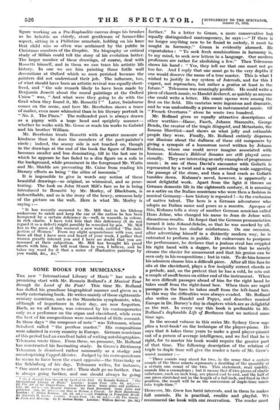ROSSETTI AND HIS CIRCLE.*
Ma. "lax •BEERB01131 has developed a new method of historical criticism. He has discovered that by means Of his inimitable gift of caricature he can shed light on an historical period, and show certain aspects of it impossible by means of the ordinary apparatus of the historian.
With only words at his command, and even with the help of a long biographical chapter, how could the ordinary historian hope to rival Mr. Beerbohm's frontispiece, which shows us " D. G. Rossetti, precociously manifesting, among the exiled patriots who frequented his father's house in Charlotte Street, that queer indifference to politics which marked him in his prime and his decline "? Here in the flash of one drawing we are made aware of the Whole situation. Here in a hubbub of argument, of moustaches and dressing-gowns, we see all '48 before us, while in the front little Gabriel scribbles drawings on the floor. Another drawing crystallizing a general attitude of mind is the one in which two county members and two artists, Millais and Holman Hunt, stand together looking respectively at the figures of Dizzy and Rossetti, while they say " Very clever, no doubt—full of wonderful ideas, but—not to be trusted for one moment." Could a volume describe better the fascination and distrust aroused in their respective spheres by these two aliens ? One drawing is headed " A momentary vision that once befell the Young Millais." The tall, thin * &argil and his Circle. By Max 4cerbohm. London : Heluemann.
figure working on a Pre-Raphaelite canvas drops his brushes as he beholds an elderly, stout gentleman of farmer-like aspect, sitting in a Philistine armchair, holding on his knee that child who so often was acclaimed by the public in Christmas numbers of the Graphic. No biography or critical study of Millais could tell the story of his evolution better. The larger number of these drawings, of course, deal with Rossetti himself, and in them we can trace his artistic life history. In one we see him painting those futile wall decorations at Oxford which so soon perished because the painters did not understand their job. The influence, too, of what should have been an artistic revival was equally short- lived, and " the sole remark likely to have been made by Benjamin Jowett about the mural paintings at the Oxford Union " was, " And what were they going to do with the Grail when they found it, Mr. Rossetti ? " Later, Swinburne comes on the scene, and here Mr. Beerbohm shows a trace of malice, even more whimsical than in his literary portrait in
" No. 2. The Pines." The redheaded poet is always drawn as a pigmy with a huge head and sprightly manner— whether he walks with Mr. Gosse or reads his works to Gabriel
and his brother William.
Mr. Beerbohm treats Rossetti with a greater measure of kindness than he does the members of the poet-painter's circle ; indeed, the seamy side is not touched on, though in the drawings at the end of the book the figure of Rossetti becomes smaller and less dominating,. till in the last one in which he appears he has faded to a dim figure on a sofa in the background, while prominent in the foreground Mr. Watts and Mr. Shields are preventing Mr. Caine from reading his literary efforts as being " the allies of insomnia."
It is impossible to give in words any notion of these beautiful drawings—so original, so whimsical, and so pene- trating. The look on John Stuart Mill's face as he is being introduced to Rossetti by Mr. Morley, of Blackburn, is indescribable, and so is the irony of the heavy, sensuous lady of the picture on the wall. Here is what Mr. Morley is saying :—
" It has recently occurred to Mr. Mill that in his lifelong endeavour to catch and keep the ear of the nation he has been hampered by a certain deficiency in—well, in warmth, in colour, in rich charm. I have told him that this deficiency (I do not regard it as a defect) might possibly be remedied by you. Mr. Mill has in the press at this moment a new work, entitled ' The Sub- jection of Women.' From my slight acquaintance with you, and from all that I have seen and heard of your work, I gather that women greatly interest you and I have no doubt that you are incensed at their subjection. Mr. Mill has brought his proof sheets with him. He will read them to you, I believe, and he takes my word for it that a series of illustrative paintings by you would, &c., &c."



































































 Previous page
Previous page